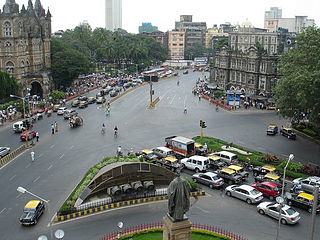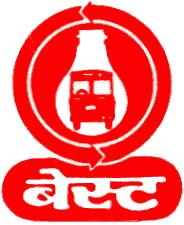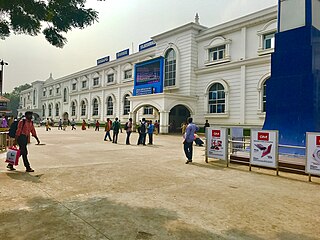
Transport in India consists of transport by land, water and air. Road transport is the primary mode of transport for most Indian citizens, and India's road transport systems are among the most heavily used in the world.

Rail transport in India consists of primarily of passenger and freight shipments along an integrated rail network. Indian Railways (IR), a statutory body under the ownership of the Ministry of Railways of the Government of India, operates India's national railway system. It is the primary owner and operator of rail operations throughout the country including suburban rail in major metros.

Transport in Mumbai is achieved by both public and private transport. As of 2016, 52% of commuters use public transport. Mumbai has the largest organized bus transport network among major Indian cities.

The Mumbai Suburban Railway consists of exclusive inner suburban railway lines augmented by commuter rail on main lines serving outlying suburbs to serve the Mumbai Metropolitan Region. Spread over 450 kilometres (280 mi), the suburban railway operates 2,342 train services and carries more than 7.5 million commuters daily.

The Mumbai Metro is a rapid transit system serving the city of Mumbai and the wider Mumbai Metropolitan Region in Maharashtra, India.

The Brihanmumbai Electricity Supply and Transport Undertaking (BEST) is a civic transport and electricity provider public body based in Mumbai, Maharashtra, India. It was originally set up in 1873 as a tramway company called "Bombay Tramway Company Limited". The company set up a captive thermal power station at the Wadi bunder in November 1905 to generate electricity for its trams and positioned it to also supply electricity to the city and re-branded itself to "Bombay Electric Supply & Tramways (BEST)" Company. In 1926, BEST also became an operator of motor buses. In 1947, the BEST became an undertaking of the Municipal Corporation and rebranded itself to "Bombay Electric Supply & Transport (BEST)". In 1995 the organisation was renamed to "Brihanmumbai Electric Supply & Transport (BEST)" alongside Mumbai. It now operates as an autonomous body under the Municipal Corporation.

The Andhra Pradesh State Road Transport Corporation, officially Andhra Pradesh Raastra Roadu Ravaana Samstha, is the state-owned road transport corporation in the Indian state of Andhra Pradesh. Its headquarters is located at NTR Administrative Block of RTC House in Pandit Nehru bus station of Vijayawada. Many other Indian metros & towns in Telangana, Tamil Nadu, Karnataka, Odisha and Chhattisgarh are also linked with the APSRTC services.

The Hyderabad Metro is a rapid transit system, serving the city of Hyderabad, Telangana, India. It is the third longest operational metro network in India after Delhi Metro and Namma Metro (Bengaluru), and the lines are arranged in a secant model. It is funded by a public–private partnership (PPP), with the state government holding a minority equity stake. Hyderabad Metro is the world's largest elevated Metro Rail system based on DBFOT basis. A special purpose vehicle company, L&T Metro Rail Hyderabad Ltd (L&TMRHL), was established by the construction company Larsen & Toubro to develop the Hyderabad metro rail project.

Secunderabad Junction railway station is an NSG–1 category Indian railway station in Secunderabad railway division of South Central Railway zone. It is the major Railway Junction in the city of Hyderabad, Telangana, India. It is one of the busiest railway stations in South India and one of the most important hubs in the country and a commuter rail hub in the Hyderabad urban area. Built in 1874 by the Nizam of Hyderabad during the British era, it was the main station of Nizam's Guaranteed State Railway until the Kacheguda railway station opened in 1916. The station was taken over by Indian Railways in 1951, when NGSR was nationalised. Its main portico and concourse are influenced by Nizamesque architecture. The station, which resembles a fort, is a tourist attraction in the twin cities of Hyderabad and Secunderabad.

Expressways are the highest class of roads in India. As of December 2024, the total length of expressways in India was 6,059 km (3,765 mi), with 11,127.69 km (6,914.43 mi) under construction. As per NHAI and Indian Roads Congress, expressways are access controlled highways with a divided carriageway, designed for high speed vehicular movement and heavy traffic. There is a central reservation or median that separates the flow travelling in opposite directions. Entrance and exits are provided only by grade separated interchanges. The interchanges may be system interchanges used with other national or state highways or be service interchanges used with smaller roads. In contrast, National highways may or may not be divided by a median and may or may not have access control. Some highways, built by State Governments, which may be fully access controlled or may be limited access controlled, are declared or named as expressways by their respective State Governments.

Vijayawada Junction Railway Station is an Indian Railways station in Vijayawada of Andhra Pradesh, categorized as a Non-Suburban Grade-1 (NSG-1) station in Vijayawada railway division. Situated at the junction of Howrah–Chennai and New Delhi–Chennai main lines, it is the fourth busiest railway station in the country after Howrah Junction, Kanpur Central and New Delhi. The station serves about 1.40 lakh passengers, over 190 express and 170 freight trains every day. It is one of the major railway junctions of the Indian Railways and is a nationally important halt. In September, 2023 It has been awarded Platinum Rating Certificate for its Environmental projects from IGBC

The Airport Express Line or Orange Line is a Delhi Metro line from New Delhi to Yashobhoomi Dwarka Sector - 25, linking Indira Gandhi International Airport. The total length of the line is 22.7 km (14.1 mi), of which 15.7 km (9.8 mi) is underground and 7.0 km (4.3 mi), from Buddha Jayanti Park to Mahipalpur, elevated.

Urban rail transit in India plays an important role in intracity transportation in the major cities which are highly populated. It consists of Regional Rapid Transit System, suburban rail, monorail, and tram systems.

The Delhi Metro is a rapid transit system that serves Delhi and the adjoining satellite cities of Ghaziabad, Faridabad, Gurugram, Noida, Bahadurgarh, and Ballabhgarh in the National Capital Region of India. The system consists of 10 colour-coded lines serving 256 stations, with a total length of 350.42 kilometres (217.74 mi). It is India's largest and busiest metro rail system and the second-oldest, after the Kolkata Metro. The metro has a mix of underground, at-grade, and elevated stations using broad-gauge and standard-gauge tracks. The metro makes over 4,300 trips daily.

More Card is a rechargeable smart card for paying transportation fares in public transport systems in India. Tipped as a nationwide interoperable transport card, the card aims to be a single point of transaction, applicable in state buses, Metro and even parking. The card was launched in 2012 in Delhi, initially acting as a common card for the Delhi Metro and its feeder buses.

Ola Consumer, formerly Ola Cabs, is an Indian transportation company that provides ride-hailing services and operates other business verticals such as financial services and cloud kitchens. It is headquartered in Bangalore, and operates in 250+ Indian cities.

National Common Mobility Card (NCMC) is an open-loop, inter-operable transport card conceived by the Ministry of Housing and Urban Affairs under Prime Minister Narendra Modi's ‘One Nation, One Card' vision. It was launched on 4 March 2019. The transport card enables the user to pay for travel, toll tax, retail shopping and withdraw money.

Rapido is an Indian ride-hailing service, which primarily operates as a bike taxi aggregator. Its offerings also include auto rickshaw and taxicab hailing, parcel delivery, and third-party logistics services. Founded in 2015, the company is based in Bangalore and operates in over 100 cities, but has run into legal troubles in several locations where bike taxis are not legal.
Transport in Bengaluru consists of several intracity commute modes such as BMTC buses, Namma Metro rail services, taxis and auto rickshaws, as well as several intercity forms of transport: Government operated KSRTC, NWKRTC, KKRTC, other states RTC buses, Private bus operators, trains, and flights.

The Indian Federation of App-based Transport Workers (IFAT) is a trade union federation of ride-sharing transport workers. In India, this includes the workers on platforms such as Ola, Uber.



















